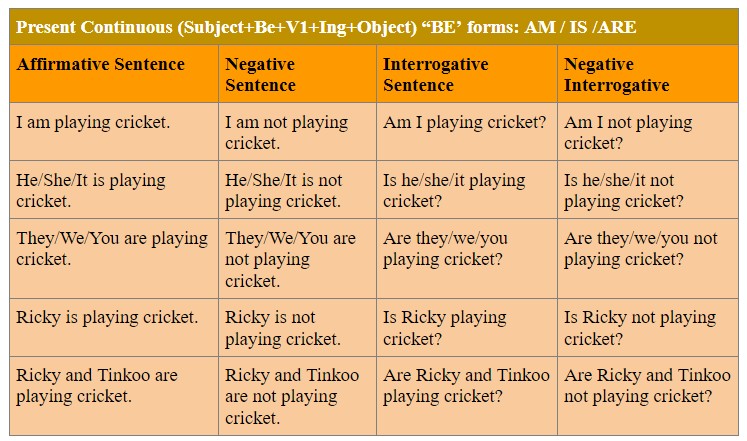Present Continuous Tense in English Grammar:
The Present Continuous Tense is also known as the Present Progressive Tense. It is used to express the presently going on (deliberate) actions.
Present Continuous Tense Structure and Formula: (Rules)
Signal Words:
It is essential to focus on signal words because they help us identify the correct tense in a sentence. The signal words for the Present Continuous Tense are:
now, at present, at the moment, don’t disturb, right now, presently, look! listen! currently….,
Usage of the Present Continuous Tense:
It is used:
To express the activity in progress at the time of speaking.
Examples:
- Now they are watching the T.V.
- She is writing an important letter at present.
- Listen, he is talking to all of us.
- Don’t disturb him, he is doing meditation.
To express the temporary activities going on now, not necessarily happening at the time of speaking.
Examples:
- They are preparing for their final semester examinations.
- He is taking medical treatment.
- He is working in the Mall as a part-timer.
To express future events when they are planned.
Examples:
(Signal words: soon, tomorrow, on Monday, next week are generally used to show futurity.)
- I am coming to Warangal next week. (future)
- I am coming to Warangal. (now)
- The teacher is taking a special class on Monday. (future)
- The teacher is taking a special class (now)
The Verbs not used in Present Continuous
Stative verbs:
The verbs which describe a state rather than an action are called stative verbs. These verbs are not normally used in the Continuous (and Perfect Continuous) Tenses. But they can be used in Simple (and Perfect) Tenses.
When we intently use in the Continuous Tenses they forego their original meaning. The common verbs related to this category are listed below.
| Verbs of Senses | hear, see, smell, taste, touch |
| Verbs of Perception | notice, recognize.., |
| Verbs of Feelings and Emotions | feel, want, wish, desire, feel, like, dislike, love, hate, hope, refuse, prefer, care, respect, admire…, |
| Verbs of Thinking | think, know, suppose, believe, find, disbelieve, doubt, agree, disagree, consider, trust, remember, forget, know, understand, misunderstand, imagine, mean, mind, remember, recollect, realize, deserve, depend…, |
| Verbs of Possession | have, possess, own, belong to, contain, consist of, comprise…, |
| Verbs of Appearing | appear, seem, resemble…, |
Observe the following sentences:
| WRONG | RIGHT |
| I am seeing a T.V. programme. | I see a T.V. programme. |
| He is not understanding it. | He does not understand it. |
| I am knowing it all along | I know it all along |
| She is tasting the curry. | She tastes the curry. |
| This house is belonging to my uncle. | This house belongs to my uncle. |
| Mother is loving her children very much. | Mother loves her children very much. |
| She was hating me like poison. | She hated me like poison. |
| He is not believing in God. | He does not believe in God. |
| I have not been seeing you for 2 years | I have not seen you for 2 years. |
| Bhaskar is wanting to become a mechanic | Bhaskar wants to become a mechanic |
| He is thinking that he is a hero | He thinks that he is a hero |
Note: 1 Use of See, Hear, Look, Listen:
See and Hear are non-intentional (deliberate) actions:
Look and Listen are intentional (deliberate) actions:
Examples:
- He sees the picture.
- I am looking at the picture.
- He hears the noise from the next room.
- I am listening to music.
But:
- The Judge is hearing the case. (right)
- The chef is tasting the curry. (right)
Note:2 Use of Have:
‘Have’ should not be used in Present Continuous Tense in the meaning of possession.
Examples:
- I am having a car. (wrong)
- I have a car. (right)
- She is not having a wristwatch. (wrong)
- She has no wristwatch. (right)
But in some expressions like have breakfast, have a bath, have a good time, have a ride etc.,
‘Have’ can be used in the Present Continuous Tense.
Examples:
- They are having their breakfast.
- I am having a good time with you all.



Comments are closed.